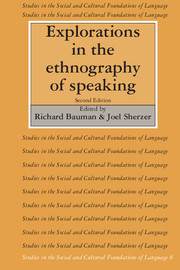Book contents
- Frontmatter
- Contents
- INTRODUCTION TO THE SECOND EDITION
- I PREFACE AND INTRODUCTION
- II COMMUNITIES AND RESOURCES FOR PERFORMANCE
- III COMMUNITY GROUND RULES FOR PERFORMANCE
- Introduction
- 4 Warm Springs ‘Indian Time’: How the Regulation of Participation Affects the Progress of Events
- 5 Contrapuntal Conversations in an Antiguan Village
- 6 Norm-Makers, Norm-Breakers: Uses of Speech by Men and Women in a Malagasy Community
- 7 Speaking in the Light: The Role of the Quaker Minister
- IV SPEECH ACTS, EVENTS, AND SITUATIONS
- V THE SHAPING OF ARTISTIC STRUCTURES IN PERFORMANCE
- VI TOWARD AN ETHNOLOGY OF SPEAKING
- Notes
- References
- Index of names
4 - Warm Springs ‘Indian Time’: How the Regulation of Participation Affects the Progress of Events
Published online by Cambridge University Press: 05 June 2012
- Frontmatter
- Contents
- INTRODUCTION TO THE SECOND EDITION
- I PREFACE AND INTRODUCTION
- II COMMUNITIES AND RESOURCES FOR PERFORMANCE
- III COMMUNITY GROUND RULES FOR PERFORMANCE
- Introduction
- 4 Warm Springs ‘Indian Time’: How the Regulation of Participation Affects the Progress of Events
- 5 Contrapuntal Conversations in an Antiguan Village
- 6 Norm-Makers, Norm-Breakers: Uses of Speech by Men and Women in a Malagasy Community
- 7 Speaking in the Light: The Role of the Quaker Minister
- IV SPEECH ACTS, EVENTS, AND SITUATIONS
- V THE SHAPING OF ARTISTIC STRUCTURES IN PERFORMANCE
- VI TOWARD AN ETHNOLOGY OF SPEAKING
- Notes
- References
- Index of names
Summary
That people of different cultures have different concepts of time is a fairly popular notion, and one which many people find appealing in an exotic sort of way. Most often this realm of cultural diversity is dealt with in rather grand and mysterious terms that compare ‘our’ western European – derived concepts of time with those of ‘other’ cultures. Thus while we may conceive of time in primarily ‘linear’ terms, others will have an essentially ‘cyclical’ orientation; while our activity is regulated by clock and calendar units, that of others is governed by the seasonal shifts in nature.
Among the peoples of the world whose activities have been drawn on for illustration of cultural variation in concepts of time, North American Indians can only be matched in popularity by Latin Americans, as evidenced by the Indians' repeated appearances as bearers of a distinctive temporal orientation in works as diverse in approach as A. I. Hallowell's ‘Temporal Orientation in Western Civilization and a Preliterate Society’ (1937), Benjamin L. Whorf's ‘An American Indian Model of the Universe’ (1950), Edward Hall's The Silent Language (1959), and Stan Steiner's The New Indians (1968).
It is Hall's orientation toward time as a dimension of activity which in itself conveys information and is systematically organized that perhaps comes closest to the present-day orientation of the ethnography of communication, especially when he is informally discussing the meaningfulness of ‘when’ an event happens:
Whenever they want to make an important announcement they will ask: ‘When shall we let them know?’ […]
- Type
- Chapter
- Information
- Explorations in the Ethnography of Speaking , pp. 92 - 109Publisher: Cambridge University PressPrint publication year: 1989
- 2
- Cited by

